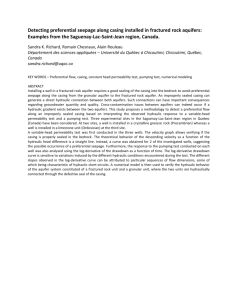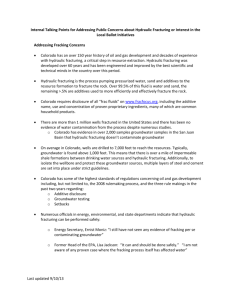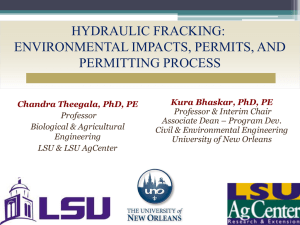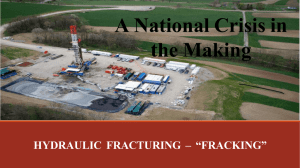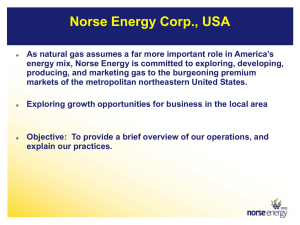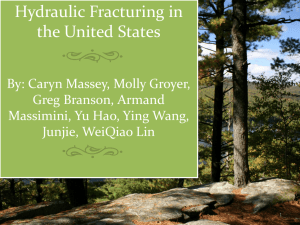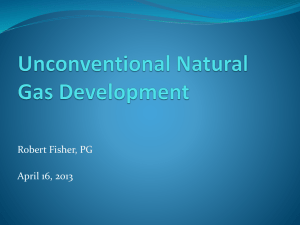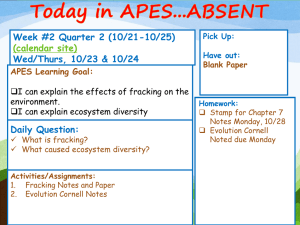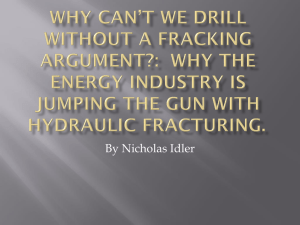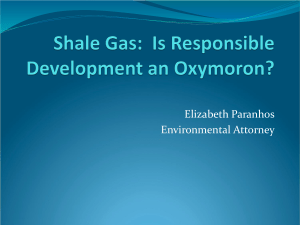Presentation by Matt Sura
advertisement
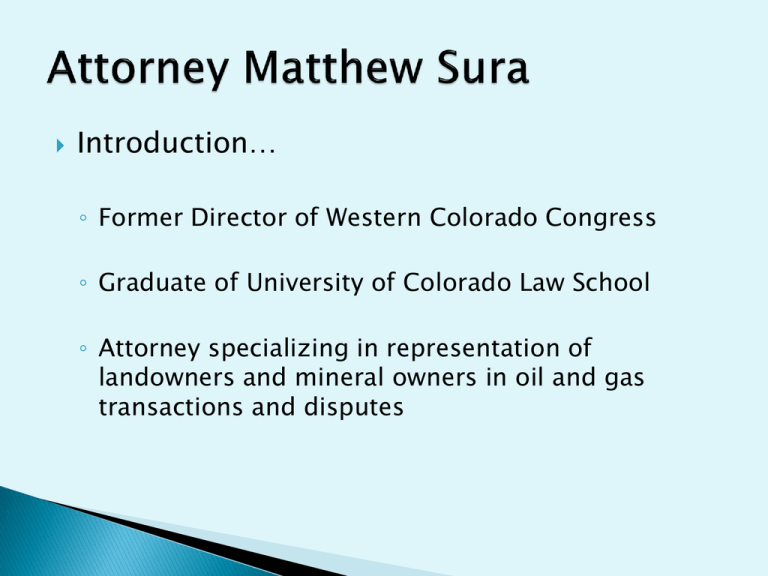
Introduction… ◦ Former Director of Western Colorado Congress ◦ Graduate of University of Colorado Law School ◦ Attorney specializing in representation of landowners and mineral owners in oil and gas transactions and disputes Landowners Alliance for NE Douglas County 3 Colorado’s Oil and Gas Basins The Jake well, which was drilled in October 2009 in Weld County, produced an average of 1,750 barrels of oil per day for the first few days -- 50,000 barrels over first 90 days. Today, oil is trading at $100 / barrel. At that price, the well paid for itself in three months ($5 million) “Anadarko estimates Colorado has up to 1.5 billion barrel oil reserve” ANNUAL COLORADO DRILLING PERMITS ISSUED 8027 NUMBER OF DRILLING PERMITS 8500 8000 7500 7000 5903 6500 6000 6368 5996 5159 5500 4400 5000 4500 4000 2917 3500 3000 2500 2245 2000 1500 1000 500 0 There are over 47,000 active wells in the state. 4659 Air Emissions Land Impact Private Property Rights Water Supply Water Handling Water Reuse & Disposal What if you had a neighbor who came on to your property and: disturbed 2-7 acres of your land, Brought constant truck traffic through your property, dug waste pits for toxic chemicals, and installed heavy, loud equipment; then tossed you $2500 for your troubles? Troubles that could be there for up to 30 years. Home on the range or industrial site? Gas wells and pumpjacks can be located as close as 150 feet from a home. Well pads and drill rigs in ranchers’ fields. IMPACTS TO THE LAND pipeline corridors across the landscape and through people’s yards, Hydraulic Fracturing 4-5 million gallons per frack. 98% water and sand, 2% fracking chemicals. Some fracking chemicals relatively safe: sodium chloride, guar gum, citric acid Some more ominous: hydrochloric acid, diesel fuel, BTEX (benzene, ethylbenzene, toluene, xylene), polycyclic aromatic hydrocarbons; methanol; formaldehyde; ethylene glycol Governor Hickenlooper called for the Colorado Oil and Gas Conservation Commission to require disclosure of the chemicals used in fracking. Several month stakeholder process and an 11-hour public hearing led to the passage of the Colorado Fracking disclosure rule. Requires the disclosure of both the identities and concentrations of all fracking chemicals. Companies may continue to seek trade secret protection for specific chemicals, but they will have to justify and certify their trade secret claims. Citizens who dispute such claims will have enhanced opportunity to get their challenges heard by the oil and gas commission or in court. SPILLS Denver Post study: From 2008-2010, average of more than a spill per day, average size of 5,300 gallons Leaking Waste Pits Hydraulic fracturing pit. . Divide Creek in Silt Colorado, April 2004, contaminated with methane and ignitable. The accident also affected water wells in three homes. WELL CONSTRUCTION STANDARDS CONDUCTOR PIPE SURFACE CASING PRODUCTION CASING CEMENT CEMENT FRESH WATER AQUIFER ZONE 400’ Usable Fresh Water Surface Casing 550’ 2100’ Various Atoka Sands & Shales 4000’ of Sediment SHALLOW PRODUCING ZONE 1300’ Upper Hale CEMENT 600’ Morrow Shale 300’ Fayetteville Shale Hindsville Cross sectional view TARGET PRODUCING ZONE GOOD MECHANICAL INTEGRITY CONDUCTOR PIPE FRESH WATER AQUIFER ZONE SURFACE CASING PRODUCTION CASING SHALLOW PRODUCING ZONE TARGET PRODUCING ZONE CEMENT CHANNELING CONDUCTOR PIPE PRESSURE BUILDS UP FRESH WATER AQUIFER ZONE SURFACE CASING CEMENT CASING FORMATION PRODUCTION CASING SHALLOW PRODUCING ZONE TARGET PRODUCING ZONE INSUFFICIENT CEMENT COVERAGE CONDUCTOR PIPE PRESSURE BUILDS UP FRESH WATER AQUIFER ZONE SURFACE CASING PRODUCTION CASING SHALLOW PRODUCING ZONE TARGET PRODUCING ZONE Emission Type • • • • • NOx SO2 CO CH4 VOCs (incl. BTEX) Reduction Technology • • • • • Catalytic reduction Ultra-low sulfur diesel fuel LNG and CNG fuels Oxidation catalysts Green completions, vapor recovery units, low bleed/no bleed pneumatic devices, plunger lift systems, leak detection Emission Levels • • • • EPA Industry State regulators Research groups OZONE VOCs SMOG Uncontrolled Emissions Estimates from Oil and Natural Gas Well Completions and Recompletions Emissions (Mcf/event) Emissions (tons/event) Methane Methane VOC HAP Natural Gas Well Completion without Hydraulic Fracturing 38.6 0.8038 0.12 0.009 Natural Gas Well Completion with Hydraulic Fracturing 7,623 158.55 23.13 1.68 Natural Gas Well Recompletion without Hydraulic Fracturing 2.59 0.0538 0.0079 0.0006 Natural Gas Well Recompletion with Hydraulic Fracturing 7,623 158.55 23.13 1.68 Well Completion Category BOTTOM LINE: 240 times more air pollution from uncontrolled Oil and natural gas well completions and recompletions US EPA, Oil and Natural Gas Sector: Standards of Performance for Crude Oil and Natural Gas Production, Transmission, and Distribution. July 2011 Dust and emissions from heavy truck traffic Argument for state control: oil and gas commission has expertise and experience in a highly technical field. There is a need for uniformity Argument for local government role: Local land use conflicts are best solved by local government. Local government should be part of monitoring of the industry. Local process gives local community a voice Cannot ban or prohibit oil and gas development Can exercise control over development up to the point of “operational conflict” with state authority State setback: drilling and fracking can happen 350 feet from homes in residential areas, 150 feet elsewhere SETBACKS FROM HOMES Matthew Sura Attorney at Law (720) 563-1866 mattsura.law@gmail.com
